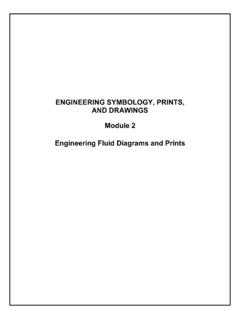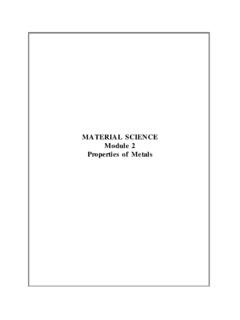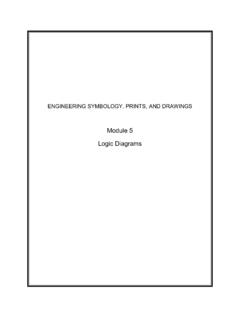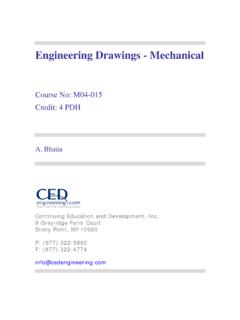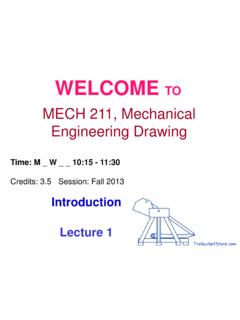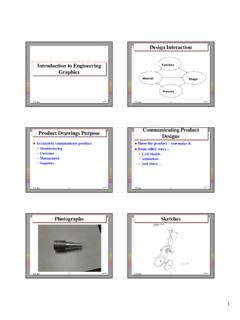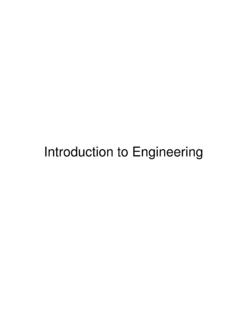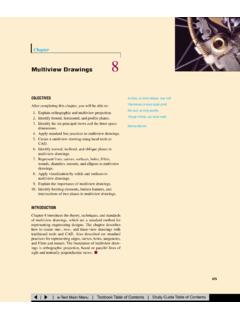Transcription of ENGINEERING SYMBOLOGY, PRINTS, AND DRAWINGS
1 ENGINEERING symbology , PRINTS, AND DRAWINGS Module 1 introduction to print Reading ENGINEERING symbology , Prints, & DRAWINGS Intro to print Reading ii TABLE OF CONTENTS T able of Co nte nts TABLE OF CONTENTS .. ii LIST OF FIGURES .. iii LIST OF TABLES .. iv REFERENCES .. v vi introduction TO print READING ..1 Anatomy of a Drawing ..2 The Title Block ..2 Grid Revision Block ..6 Changes ..7 Notes and Legend ..8 Summary ..9 introduction TO THE TYPES OF DRAWINGS , VIEWS, AND PERSPECTIVES ..10 Categories of DRAWINGS ..10 Piping and Instrument DRAWINGS (P&IDs) ..10 Electrical Single Lines and Schematics ..11 Electronic Diagrams and Schematics ..13 Logic Diagrams and Prints ..14 Fabrication, Construction, and Architectural DRAWINGS ..14 Drawing Format ..16 Views and Perspectives ..19 Summary ..21 ENGINEERING symbology , Prints, & DRAWINGS Intro to print Reading iii LIST OF FIGURES Figure 1 Title Block.
2 3 Figure 2 Example of a Grid .. 5 Figure 3 Revision Block .. 6 Figure 4 Methods of Denoting Changes .. 7 Figure 5 Notes and Legends .. 8 Figure6 Example P&ID .. 10 Figure 7 Example of a Single Line .. 11 Figure 8 Example of a Schematic .. 12 Figure 9 Example of an Electronic Diagram .. 13 Figure 10 Example of a Logic print .. 14 Figure 11 Example of a Fabrication Drawing .. 15 Figure 12 Example of a Single Line P&ID .. 16 Figure 13 Example Pictorial .. 17 Figure 14 Example of an Assembly Drawing .. 17 Figure 15 Example of a Cutaway .. 18 Figure 16 Example Orthographic Projection .. 19 Figure 17 Orthographic Projections .. 20 Figure 18 Example of an Isometric .. 20 ENGINEERING symbology , Prints, & DRAWINGS Intro to print Reading iv LIST OF TABLES NONE ENGINEERING symbology , Prints, & DRAWINGS Intro to print Reading v REFERENCES ASME , Dimensioning and Tolerancing IEEE Std 315-1975 (Reaffirmed 1993), Graphic Symbols for Electrical and Electronic Diagrams Gasperini, Richard E.
3 , Digital Troubleshooting, Movonics Company; Los Altos, California, 1976. Jensen - Helsel, ENGINEERING Drawing and Design, 7th Ed., McGraw-Hill Book Company, New York (August 15, 2007) Lenk, John D., Handbook of Logic Circuits, Reston Publishing Company, Reston, Virginia, 1972. Wickes, William E., Logic Design with Integrated Circuits, John Wiley & Sons, Inc, 1968. Naval Auxiliary Machinery, United States Naval Institute, Annapolis, Maryland, 1951. TPC Training Systems, Reading Schematics and Symbols, Technical Publishing Company, Barrington, Illinois, 1974. Arnell, Alvin, Standard Graphical Symbols, McGraw-Hill Book Company, 1963. George Masche, Systems Summary of a Westinghouse Pressurized Water Reactor, Westinghouse Electric Corporation, 1971. Smith-Zappe, Valve Selection Handbook, 5th Ed., Gulf Publishing Company, Houston, Texas, December 2003. ENGINEERING symbology , Prints, & DRAWINGS Intro to print Reading vi OBJECTIVES TERMINAL OBJECTIVE Given an ENGINEERING print , READ and INTERPRET the information contained in the title block, the notes and legend, the revision block, and the drawing grid.
4 ENABLING OBJECTIVES STATE the five types of information provided in the title block of an ENGINEERING drawing. STATE how the grid system on an ENGINEERING drawing is used to locate a piece of equipment. STATE the three types of information provided in the revision block of an ENGINEERING drawing. STATE the purpose of the notes and legend section of an ENGINEERING drawing. LIST the five drawing categories used on ENGINEERING DRAWINGS . ENGINEERING symbology , Prints, & DRAWINGS Intro to print Reading 1 introduction TO print READING A through knowledge of the information presented in the title block, the revision block, the notes and legend, and the drawing grid is necessary before a drawing can be read. This information is displayed in the areas surrounding the graphic portion of the drawing. EO STATE the five types of information provided in the title block of an ENGINEERING drawing.
5 EO STATE how the grid system on an ENGINEERING drawing is used to locate a piece of equipment. EO STATE the three types of information provided in the revision block of an ENGINEERING drawing. EO STATE the purpose of the notes and legend section of an ENGINEERING drawing. introduction The ability to read and understand information contained on DRAWINGS is essential to perform most ENGINEERING -related jobs. ENGINEERING DRAWINGS are the industry's means of communicating detailed and accurate information on how to fabricate, assemble, troubleshoot, repair, and operate a piece of equipment or a system. To understand how to "read" a drawing it is necessary to be familiar with the standard conventions, rules, and basic symbols used on the various types of DRAWINGS . But before learning how to read the actual "drawing," an understanding of the information contained in the various non-drawing areas of a print is also necessary.
6 This chapter will address the information most commonly seen in the non-drawing areas of a nuclear grade ENGINEERING type drawing. Because of the extreme variation in format, location of information, and types of information presented on DRAWINGS from vendor to vendor and site to site, all DRAWINGS will not necessarily contain the following information or format, but will usually be similar in nature. In this handbook the terms print , drawing, and diagram are used interchangeably to denote the complete drawing. This includes the graphic portion, the title block, the grid system, the revision block, and the notes and legend. When the words print , drawing, or diagram, appear in quotes, the word is referring only to the actual graphic portion of the drawing. ENGINEERING symbology , Prints, & DRAWINGS Intro to print Reading 2 Anatomy of a Drawing A generic ENGINEERING drawing can be divided into the following five major areas or parts.
7 1. Title block 2. Grid system 3. Revision block 4. Notes and legends 5. ENGINEERING drawing (graphic portion) The information contained in the drawing itself will be covered in subsequent modules. This module will cover the non-drawing portions of a print . The first four parts listed above provide important information about the actual drawing. The ability to understand the information contained in these areas is as important as being able to read the drawing itself. Failure to understand these areas can result in improper use or the misinterpretation of the drawing. The Title Block The title block of a drawing, usually located on the bottom or lower right hand corner, contains all the information necessary to identify the drawing and to verify its validity. A title block is divided into several areas as illustrated by Figure 1.
8 First Area of the Title Block The first area of the title block contains the drawing title, the drawing number, and lists the location, the site, or the vendor. The drawing title and the drawing number are used for identification and filing purposes. Usually the number is unique to the drawing and is comprised of a code that contains information about the drawing such as the site, system, and type of drawing. The drawing number may also contain information such as the sheet number, if the drawing is part of a series, or it may contain the revision level. DRAWINGS are usually filed by their drawing number because the drawing title may be common to several prints or series of prints. Second Area of the Title Block The second area of the title block contains the signatures and approval dates, which provide information as to when and by whom the component/system was designed and when and by whom the drawing was drafted and verified for final approval.
9 This information can be invaluable in locating further data on the system/component design or operation. These names can also help in the resolution of a discrepancy between the drawing and another source of information. ENGINEERING symbology , Prints, & DRAWINGS Intro to print Reading 3 Figure 1 Title Block Third Area of the Title Block The third area of the title block is the reference block. The reference block lists other DRAWINGS that are related to the system/component, or it can list all the other DRAWINGS that are cross-referenced on the drawing, depending on the site's or vendor's conventions. The reference block can be extremely helpful in tracing down additional information on the system or component. Other information may also be contained in the title block and will vary from site to site and vendor to vendor.
10 Some examples are contract numbers and drawing scale. ENGINEERING symbology , Prints, & DRAWINGS Intro to print Reading 4 Drawing Scale All DRAWINGS can be classified as either DRAWINGS with scale or those not drawn to scale. DRAWINGS without a scale usually are intended to present only functional information about the component or system. Prints drawn to scale allow the figures to be rendered accurately and precisely. Scale DRAWINGS also allow components and systems that are too large to be drawn full size to be drawn in a more convenient and easy to read size. The opposite is also true. A very small component can be scaled up, or enlarged, so that its details can be seen when drawn on paper. Scale DRAWINGS usually present the information used to fabricate or construct a component or system. If a drawing is drawn to scale, it can be used to obtain information such as physical dimensions, tolerances, and materials that allows the fabrication or construction of the component or system.
